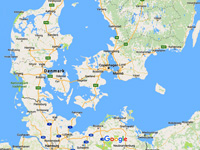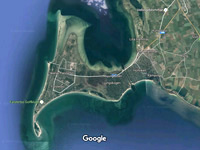

Falsterbo is a village on a narrow peninsula at the very south-western end of Sweden, and as such is a natural funnel for autumn migrants leaving Scandinavia on their way south, and looking for the shortest sea-crossing to Denmark and Germany. It is particularly important for the larger soaring birds of prey, which try to avoid crossing large expanses of water as much as possible. The two maps below show both the detail of the area around Falsterbo itself, but also how it fits into the wider picture – it lies just south of Malmö on the larger map. [Click on all images for larger versions]
Roger had visited the area twice before, and kindly organised all the travel, accommodation and transport arrangements. We flew from Bristol to Copenhagen with EasyJet in the afternoon of the 26th, collected our hire car, and drove the short distance from the airport to the impressive Oresund bridge, which in fact starts with a 4 km tunnel under the sea to the specially created artificial island of Peberholm ('Pepperholm' in English, as the existing island just to the north is called 'Saltholm' – don't let anyone tell you the Danes don't have a sense of humour). From here it is 8 km of actual bridge to the Swedish mainland and as the main road skirts Malmö, you can be in Falsterbo in 45 minutes. We checked into Falsterbo Kursgård, our accommodation in Höllviken, at the east end of the peninsula, a complex of individual chalets in wooded surroundings. Although perhaps a bit dated, the rooms suited us just fine, and the buffet breakfasts were good.
We had time for a recce of the onward route, over a canal, through Ljunghusen, across the heath (of which more later), through the attractive old village of Falsterbo itself, to a small carpark at the entrance to the golfcourse that occupies most of the end of the peninsula. A quick look produced about 15 Yellow Wagtails, plus some Oystercatchers and Curlews on the greens, and a Marsh Harrier nearer the coast. In the evening, we walked the short distance to Höllviken centre where there were several restaurants to choose from – Bistro'n turned out to be a good choice.
Like the previous evening, the weather was warm, calm and sunny, and it remained like this all day. We were at the golfclub entrance by 8.30, to find the carpark full, so we lengthened the queue of birders' cars parked (probably illegally) back along the access road and walked across the golfcourse to the old lighthouse (where some of the birders had gathered) and checked the lagoons and reeds that stretch from here to the point, between the greens and the sea on the west side of the peninsula. Coots, a couple of Little Grebes, a calling Water Rail, the first migrating Sparrowhawk, a Marsh Harrier, at least 40 Yellow Wagtails plus a few White Wagtails on the greens, and various hirundines were quickly added to the list. We joined the main group of birders, including the official counter who is there throughout the migration season (August to November), and stayed until midday.
During this time a string of Sparrowhawks (11+) went through, as did several Red Kites and Marsh Harriers, although some of the latter seemed to be hunting rather than migrating, as were a couple of Kestrels. Swallows, House Martins, at least one Sand Martin, good numbers of Yellow Wagtails, several Tree Pipits and Sandwich Terns were also moving through. We were assured that the flock of about two dozen Tree Sparrows that flew over chirping were actually resident – the locals were surprised to hear how rare they were becoming in the UK. The lagoon, a restricted area beyond the golfcourse all the way to the sandy spit at the very end of the point, was productive, with plenty of Mallard, Teal and Goldeneye, plus smaller numbers of Shelduck, Shoveler, Wigeon and Pintail on the water, plus a couple of Spotted Redshanks, an Avocet and a Black-necked Grebe also present. Offshore were a few Eider, plenty of Cormorants, and a few Greylag Geese in flight.
Back at the lighthouse (the site of the Falsterbo Bird Observatory and ringing station), there were at least 7 Red Kites, 5 Sparrowhawks and 5+ Common Buzzards, some very pale, circling over the patches of woodland here, and we found one Honey Buzzard among them. However, it looked as if they were reluctant to go much further today, despite the sunny weather. A Nuthatch called from the woodland, and we saw both Willow Warbler and Chiffchaff on the golfcourse, although in general woodland passerines were not very obvious throughout this trip.
We spent the early afternoon at 'the heath', one of the other main watchpoints, in the shade of trees at the western end of the open flat heathland east of Falsterbo village, where birders gather to look for raptors approaching from over the woodland of Ljunghusen, a couple of km to the east.
During a couple of hours here we saw at least 10 Red Kites, a mix of Common and Honey Buzzards, some seen well, but others very high and hard to be sure of, and several Sparrowhawks. Two White-tailed Eagles, an adult and a sub-adult, also put in an appearance, no doubt residents, but the 25 or so White Storks heading west were a bit of a surprise to us. We then had a short break to explore the sandy coast and lagoons on the south side of the heath (apparently a breeding site for Tawny Pipit), producing distant views of a couple each of Spotted Redshank and Bar-tailed Godwit, and a semi-albino Oystercatcher but not a lot else apart from a Carrion Crow (Hooded Crow is the common crow here). We then returned to the heath where we saw several more Common Buzzards and Sparrowhawks, a Marsh Harrier and an Osprey but the bird that got everyone jumping up and running for a clear view was the Short-toed Eagle that appeared almost overhead, fairly high up, but in view for a reasonable length of time before continuing west.
We finished the day with a quick look at the meadows just north of the attractive village of Skanör, where a flock of about 200 Barnacle Geese in flight was a good addition to the day's total. Incidentally, in Ikea-speak, Skanör is a glass-fronted cupboard, while Falsterbo gives its name to a wall-shelf – did you need to know that?
This morning couldn't have been more different, with torrential rain, lightning and thunder as we waded our way to breakfast. Migration watching was out of the question, but Roger had a Plan B ready, so we headed off north-east past Malmö to look for a couple of lakes some way east of Dalby. After 45 minutes we were at the little village of Vomb, first having checked a small woodland lake just to its south, though it produced only Cormorant and Great Crested Grebe. The large lake (Vombsjön) just to the north was so wind- and rain-lashed that nothing much could be made out in that direction, but across the road was a more sheltered tower hide overlooking a vast expanse of grassland, part of the reserve of Klingavälsån-Krankesjön, after the river and lake of those names respectively. Four distant Cranes in flight were good to latch on to. We had already made a detour west of Vomb into another part of the reserve, seeing several Red Kites, a Kestrel and a Hobby over the edge of the village, so we returned there and drove slowly west, passing more hides on the way. A Whinchat on the fence by the road, some Yellow Wagtails and Skylarks in the stubble, a few Greylag Geese in the fields, and a White-tailed Eagle in the distance indicated that this was an area well worth the detour. Apparently it is one of the areas where White Storks are being reintroduced, thus explaining the ones we had seen on the move yesterday.
We continued to the far side of the reserve and along various forestry tracks to get a view of the smaller lake in this area (Krankesjön), but only managed to do so in one spot, with a large flock of Mute Swans, two Whooper Swans, a few Goldeneye and a Raven overhead the main birds of note. So we returned to the Klingavälsån part of the reserve, and spent some time scanning from one of the tower hides over lunch, rewarded with a huge flock (200+) of Greylag Geese coming in to land, and about a dozen Cranes, four of which flew past at close range, always a wonderful sight.
As by now it had brightened up, we decided to return to Falsterbo, seeing five more White Storks over the road near Dalby on the way. Back at the lighthouse there were still quite a few Sparrowhawks and one or two Marsh Harriers circling around, a Tree Pipit landed, but none of the birds seemed to want to head off, or at least if they did so, they soon returned. We spent some time at the point, seeing much the same mix of ducks on the sea and lagoon as before, but with a few more waders, including Sanderling, Knot, Bar-tailed Godwit, Dunlin, Ringed Plover, Greenshank and Avocet, plus an adult Arctic Tern. In the evening, we made a second visit to the Bella Donna Italian restaurant in Höllviken, also to be recommended.
No rain this morning, but quite a strong south-westerly wind. Having checked out of our rooms, we drove to the golfcourse by 8.15 and spent some time in the shelter of the wood by the lighthouse, where a Hobby was picking off some of the local dragonflies, a Marsh Harrier was quartering the reeds and Sparrowhawks, no doubt a bit frustrated by the conditions, popped up from time to time, while White Wagtails had replaced the Yellows on the fairways. Out at the point, a Caspian Tern heading south-west was the star bird, while a large flock of Common Scoter on the sea boosted the list. As clearly the wind was holding back migration, we decided to check out one of the other main viewing points, the west side of the canal that cuts across the peninsula. A few Sandwich Terns and the inevitable Sparrowhawk were noted here, and an Eider in the harbour at the southern end. We also had a look at the meadows on the peninsula north of Höllviken, where small numbers of Yellow and White Wagtails were feeding, but our attempt to add House Sparrow to the list only produced yet another Tree Sparrow. By midday it was time to head back to the accommodation, collect our luggage, drive back over the Oresund bridge to Copenhagen, and catch the late afternoon flight back to Bristol.
In all we saw 91 species, without spending much time looking for 'padders', and with access so quick and easy from Bristol, this is a site we might well be visiting again.